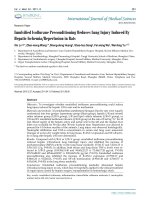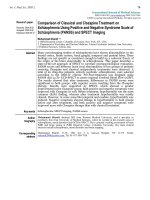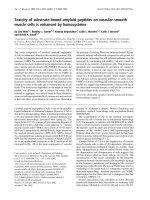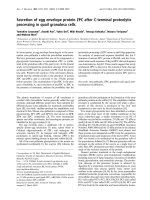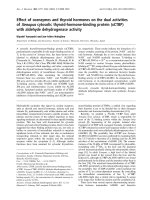Báo cáo y học: "Influence of Cyclodextrin Complexation with NSAIDs on NSAID/Cold Stress-Induced Gastric Ulceration in Rats"
Bạn đang xem bản rút gọn của tài liệu. Xem và tải ngay bản đầy đủ của tài liệu tại đây (1.45 MB, 8 trang )
Int. J. Med. Sci. 2010, 7
232
I
I
n
n
t
t
e
e
r
r
n
n
a
a
t
t
i
i
o
o
n
n
a
a
l
l
J
J
o
o
u
u
r
r
n
n
a
a
l
l
o
o
f
f
M
M
e
e
d
d
i
i
c
c
a
a
l
l
S
S
c
c
i
i
e
e
n
n
c
c
e
e
s
s
2010; 7(4):232-239
© Ivyspring International Publisher. All rights reserved
Research Paper
Influence of Cyclodextrin Complexation with NSAIDs on NSAID/Cold
Stress-Induced Gastric Ulceration in Rats
Ibrahim A. Alsarra
1,2,
, Mahrous O. Ahmed
1
, Fars K. Alanazi
1,3
, Kamal Eldin Hussein ElTahir
4
, Abdulmalik
M. Alsheikh
5
and Steven H. Neau
6
1. Department of Pharmaceutics, College of Pharmacy, King Saud University, P.O. Box 2457, Riyadh 11451, Saudi Arabia
2. Center of Excellence in Biotechnology Research, King Saud University, P.O. Box 2460, Riyadh 11451, Saudi Arabia
3. Kayyali Chair for Pharmaceutical Industry, College of Pharmacy, King Saud University, P.O. Box 2457, Riyadh 11451,
Saudi Arabia
4. Department of Pharmacology, College of Pharmacy, King Saud University, P.O. Box 2457, Riyadh 11451, Saudi Arabia
5. Department of Pathology, Faculty of Medicine, King Saud University, P.O. Box 2925, Riyadh 11461, Saudi Arabia
6. Department of Pharmaceutical Sciences, Philadelphia College of Pharmacy, University of the Sciences in Philadelphia,
600 South 43rd Street, Philadelphia, PA 19104, USA
Corresponding author: Dr. Ibrahim A. Alsarra, Phone: +(966)-1-4677504, Fax: +(966)-1-4676363, E-mail: ialsar-
Received: 2010.04.15; Accepted: 2010.06.30; Published: 2010.07.05
Abstract
The aim of this work was to study the ability of β-cyclodextrin (β-CD) or hydroxypropyl
β-cyclodextrin (HP-β-CD) to ameliorate the induction of gastric ulcers by a nonsteroidal
anti-inflammatory drug, indomethacin or piroxicam, in rats exposed to restraint and hypo-
thermic stress at 4 °C. Using oral gavage, rats fasted for 72 h were administered the equivalent
of a 100 mg/kg dose of the assigned drug, alone or with the designated cyclodextrin (CD). The
rats were placed in suitable rodent restrainers and then placed inside a ventilated refrigerator
maintained at a temperature of 4 °C. Six hours later, each animal was removed, anaesthetized
with ether, and the abdomen opened. Each stomach was removed, opened along the greater
curvature and gently rinsed with isotonic saline solution. The induced gastric ulcers were
examined and assessed with the help of a 10x binocular magnifier. Pronounced and marked
gastric ulceration with complete loss of the mucosa, extensive deposition of fibrin and dense
neutrophilic infiltrate were observed in rats treated with each of the drugs alone. Treatment
with indomethacin or piroxicam alone induced ulcer indices of 26 ± 2.3 or 14 ± 1.8, respec-
tively. However, β-CD and HP-β-CD each significantly suppressed ulceration due to restraint
and cold stress. Rats treated with indomethacin or piroxicam in the presence of either β-CD
or HP-β-CD exhibited normal tissues. Therefore, β-CD and HP-β-CD act as protective
agents against gastrointestinal disorders produced by restraint and cold stress, even with the
added stress from administration of either indomethacin or piroxicam.
Key words: β-cyclodextrin, hydroxypropyl β-cyclodextrin, indomethacin, piroxicam, gastric ulcers,
histological examination
Introduction
Although oral nonsteroidal anti-inflammatory
drugs (NSAIDs) are effective in the treatment of a
variety of acute and chronic pain conditions, their use
has been associated with the induction of gastric in-
jury, which is the most common adverse effect [1].
Physical and psychological stresses are triggers or
modifiers of the clinical course of gastrointestinal
disorders, such as peptic ulcer, irritable bowel syn-
Int. J. Med. Sci. 2010, 7
233
drome, or inflammatory bowel disease [2]. Stress can
act synergistically with other pathogenic factors, such
as Helicobacter pylori, nonsteroidal an-
ti-inflammatory drugs, or colitis-inducing chemicals
to produce gastrointestinal disease [2]. It has been
demonstrated that restraint and cold (4
o
C), as well as
indomethacin [3-5], can induce ulceration.
The principal mechanism of action of all NSAIDs
is the inhibition of the biosynthesis of prostaglandins
by blocking the activity (selectively and/or
non-selectively) of two isoforms of cyclooxygenase
enzyme (COX-1 and COX-2) [6-8]. With the exception
of aspirin, NSAIDs inhibit synthesis of prostaglandins
(mediators of inflammation) via competition with
arachidonic acid for the two isoforms. Generally, in
the absence of any pathological conditions, conti-
nuous release of prostaglandins usually contributes to
certain physiological functions in both humans and
animals. These include inhibition of gastric acid se-
cretion, regulation of vascular tone, regulation of ren-
al blood flow, and regulation of platelet aggregation
[11,12].
The gastric ulcerogenic action of NSAIDs is be-
lieved to occur mainly due to their local inhibitory
effect on gastric prostaglandin E2 (PGE
2
) and pros-
taglandin I2 (PGI
2
) that are the main inhibitors of
gastric acid secretion [13,14]. The major contribution
of the local ulcerogenic action of NSAIDs can be ap-
preciated from the decreased incidence of ulcers fol-
lowing the use of NSAIDs enteric coated tablets.
CDs are non-reducing, water-soluble oligosac-
charides with nonpolar cavities that allow complexa-
tion with the nonpolar portion of many drug mole-
cules [13]. Inclusion complexes of poorly soluble
drugs with CDs present more solubilized drug, a
greater rate of dissolution, and a more efficient ab-
sorption after oral administration, compared to un-
complexed drug [15,16]. Toxicity tests have demon-
strated that orally administered CDs are essentially
nontoxic, largely because they are not absorbed from
the gastrointestinal tract [17]. Gastric ulceration in-
duced by oral administration of flurbiprofen was sig-
nificantly decreased by the presence of CDs, in par-
ticular by β-CD [18].
Indomethacin is one of the first an-
ti-inflammatory drugs introduced for closure of pa-
tent ductus arteriosus of newborns and treatment of
various inflammatory conditions [13]. The complex of
indomethacin with CDs has been well studied [19-22]
in solution and in the solid state [13,19,20]. It accom-
plishes a 1:1 inclusion complex with β-CD or
HP-β-CD [22] by inserting either the p-chlorobenzoic
portion or the indole unit of the molecule into the CD
cavity [23-25]. In addition, inclusion complexes of
indomethacin with β-CD or HP-β-CD were prepared
and evaluated in vivo [21,22]. These inclusion com-
plexes have the ability to reduce gastrointestinal ad-
verse effects [23,24].
The oxicams are a class of NSAIDs that have
made a considerable impact since their introduction.
However, some concern has been expressed about the
apparent high risk of gastrointestinal side effects as-
sociated with the use of some oxicams [26]. As a re-
sult, research efforts have been directed toward iden-
tifying a chemical that combines the potency of the
oxicam class with a reduced risk of unwanted effects.
Piroxicam is a potent NSAID that is used in the
treatment of rheumatoid arthritis, osteoarthritis,
traumatic contusions, and different regional inflam-
matory disorders [27]. It was reported that the inclu-
sion complex of piroxicam with β-cyclodextrin (β-CD)
in solution and solid states was obtained with a 1:1
stoichiometry [18,28,29]. Moreover, the inclusion be-
haviors of piroxicam with β-CD, HP-β-CD, and car-
boxymethyl β-CD were investigated and the highest
inclusion capacity was obtained with β-CD [30].
Since gastric ulceration induced by flurbiprofen
(log P = 4.24) [31] was substantially reduced by β-CD,
it would be appropriate to investigate the effect of
CDs as protective agents against ulceration induced
by more hydrophilic NSAIDs, namely indomethacin
(log P = 3.8) [31,32] and piroxicam (log P = 0.59) [33
]
,
where CD inclusion becomes less important for solu-
bilization.
The aim of the study is to compare the magni-
tude of gastric ulcers of rats under cold stress (4 ºC)
following oral treatment with indomethacin and pi-
roxicam each alone and after complexation of each
with β-CD or HP-β-CD.
Materials and Methods
β-Cyclodextrin was purchased from Acros Or-
ganics (Morris Plains, New Jersey, USA). Indometha-
cin and hydroxypropyl β-cyclodextrin with a 0.6 de-
gree of substitution were purchased from Fluka
Chemical Company (Chemie GmbH, Buchs, Switzer-
land). CDs were used as received. Piroxicam was ob-
tained from Sigma-Aldrich Chemical Company (St.
Louis, MO, USA). All remaining chemicals were ana-
lytical grade.
Preparation of CD Solutions
An aqueous solution of each CD was prepared
by dissolving accurately weighed CDs (180 mg of
β-CD and 300 mg of HP-β-CD) in 10 ml of distilled
water with the aid of a UP100H ultrasonic device,
(100W, 30kHz, Hielscher Ultrasonics, Teltow, Berlin,
Int. J. Med. Sci. 2010, 7
234
Germany) for 5 min. In the case of β-CD, a concentra-
tion of 1.8 % w/v (16 mM) was prepared. A 30 % w/v
(217.4 mM) solution of HP β-CD was also prepared.
These aqueous CDs solutions in the same concentra-
tions were used to dose the rats with the drugs.
Preparation of Piroxicam and Indomethacin
Suspensions
An aqueous suspension of piroxicam or indo-
methacin was prepared by spreading 250 mg of each
drug into 10 ml distilled water. In addition, a suspen-
sion of each drug was prepared in the presence of
either β-CD or HP β-CD by sprinkling 250 mg of each
drug into 10 ml of aqueous CD solutions with the
same concentrations (1.8% of β-CD and 30% of HP
β-CD) as described in the previous section. Ultraso-
nication was utilized to obtain a well-dispersed sus-
pension of each drug. The suspension of each drug in
the presence of CDs was considered to contain both
the soluble drug complex with CD and excess inso-
luble suspended particles of drug.
Solubility Study
The phase-solubility experiments of each drug
(piroxicam or indomethacin) with either β-CD or
HP-β-CD were carried out by the method reported by
Higuchi and Connors [34] in distilled water. A series
of volumetric flasks each containing successively in-
creasing quantities of either β-CD or HP-β-CD were
prepared. Excess of each drug was added into each
flask to maintain saturated conditions. All flasks were
sonicated for 30 min at 37±1 °C. Following equili-
brium, each supernatant phase was removed, filtered,
diluted, and assayed for the total solubilized drug
content by UV analysis. The binding constants of each
drug with each CD were calculated from the
phase-solubility slope according to the following eq-
uation:
K
1:1
=
Slope
S
o
(1 − Slope)
where S
o
is the solubility of the drug in the ab-
sence of the CD, and K
1:1
is the binding constant.
Determination of Complexed Drug with CD
The amount of complexed drug (piroxicam or
indomethacin) with either β-CD or HP-β-CD, was
determined by its distribution coefficient (partition
coefficient) in order to estimate the ratio of
free-to-complexed drug. An accurate concentration of
piroxicam (1.5 x 10
-4
M) or indomethacin (1.1 x 10
-4
M)
in 0.1 N HCl was prepared from which 5 ml was
added to 5 ml n-octanol in volumetric flasks. These
two immiscible liquids were sonicated for 15 min at 37
± 1 °C, set aside for 1.5 h, and then the aqueous phase
was separated using a separating funnel. The con-
centration of each drug was determined in the
aqueous phase spectrophotometrically at 338 nm and
267 nm for piroxicam and indomethacin, respectively.
The procedures were repeated in the presence of ei-
ther β-CD (0.016 M) or HP-β-CD (0.030 M) in the
aqueous phase. The total concentration of free and
complexed drug in the presence of CDs was meas-
ured, and the ratio of the free-to-complexed amount
was calculated. Due to the low concentration of drug
in each phase, the partition coefficients of each drug in
the absence and presence of CDs could be estimated
by the ratio of the drug concentration in the octanol
phase to the concentration in the aqueous phase.
Experimental Animals
Male Wistar rats (250 g body weight) were pro-
vided by the Experimental Animals Care Center
(College of Pharmacy, King Saud University, Riyadh,
Saudi Arabia). The animals were maintained at 22 ± 1
°C on a 12 h light-dark cycle and allowed rat chow
and water ad libitum. Nine groups of Wistar rats (n =
4 animals per group) were used. The allocation of the
animals to the groups was randomized using a stan-
dard random table. Experimental protocols were ap-
proved by the Animal Care and Use Committee and
were in accordance with the recommendations in the
University Guide for the Care and Use of Laboratory
Animals.
Before the start of the experiments, food was
withdrawn for 72 h but water was allowed ad libitum
[13]. Preliminary results have revealed that the
pre-fasting condition alone doesn’t induce ulcers, as
evidenced by the absence of ulcers in some of the
treated groups. It was found that the minimum expe-
rimental conditions for gastric induction in the Wistar
rats used in this study were: fasting (72 h), hypo-
thermic restraint stress exposure, and the administra-
tion of specified doses of the two NSAIDs.
As described in the studies by Bhargava et al.
[14], Schmassmann et al. [35] and Brzozowski et al.
[36], on the morning of the experiments each fasted
rat was administered the assigned drug by oral ga-
vage in a dose equivalent to 100 mg indomethacin or
piroxicam per kg, then restrained in an appropriate
rodent restrainer (Harvard Apparatus, Holliston,
Massachusetts, USA) and placed inside a ventilated
refrigerator, model 1852G (Norfolk Marine, Ltd.,
Norwich, Norfolk, UK), maintained at a temperature
of 4 °C. Six hours later [37], each animal was removed,
anaesthetized with ether, and the abdomen was
opened. Each stomach was removed, opened along
the greater curvature, and gently rinsed with isotonic
Int. J. Med. Sci. 2010, 7
235
saline solution. Each stomach was pinned out on a flat
surface with the mucosal surface uppermost.
Examination of Gastric Ulcers
The induced gastric ulcers were examined and
assessed with the help of a 10x binocular magnifier.
To quantify the induced ulcers in each stomach, a
modification of the scoring systems described in the
literature [35,38-41] was employed. The induced ulc-
ers in these experiments were small spots and thus
each was given a score between 1 and 4. Ulcers of 0.5
mm diameter were given a score of 1 whereas ulcers
of diameters 1 and 2 mm were given scores of 2 and 4,
respectively. For each stomach, an ulcer index was
calculated as the sum of the total score of ulcers. The
cumulative ulcer index is presented as the mean (n =
4) ± standard deviation (s.d.).
Statistical Analysis
All data are presented as the mean ± the stan-
dard deviation (s.d.). Significant differences between
the different treatment groups were determined by
one-way analysis of variance (ANOVA) using the
SPSS
®
statistical package (version 10, 1999, SPSS Inc.,
Chicago, IL). Statistical differences yielding P ≤ 0.05
were considered significant. Tukey’s multiple com-
parison post hoc test was applied when necessary.
Histological Examination
For histological examination, all samples (sto-
machs of the rats) were removed and fixed overnight
in 10 % w/v formalin. Each specimen was sectioned
and submitted totally. They were processed overnight
and then embedded in paraffin. The paraffin blocks
were sectioned and the slides were stained with a
standard haematoxylin and eosin stain and photo-
graphed under 20x magnification using a Nikon Ec-
lipse 80i light microscope (Nikon Corporation, Japan)
equipped with a digital DS-Ri1 camera.
Results and Discussion
The binding constants of piroxicam with β-CD
and HP-β-CD were found to be 105 M
-1
and 143 M
-1
,
respectively with 1:1 stiochiometry. The amounts of
complexed piroxicam with β-CD and HP-β-CD eva-
luated by distribution coefficient method were 20.6%
and 44.4%, respectively. The ratio of free-to com-
plexed piroxicam was 4:1 in case of β-CD and 5:4 in
case of HP-β-CD. The binding constant of indome-
thacin with β-CD was also determined by the solubil-
ity method in water and calculated as 278 M
-1
. These
results were in agreement with those constants re-
ported by Uekama and Otagiri [18]. The amount of
complexed indomethacin with β-CD and HP-β-CD
was evaluated by distribution coefficient between
n-octanol and 0.1 N HCl and was found as 8.3% and
26.6%, respectively. The ratio of free-to-complexed
indomethacin was 11:1 in the case of β-CD, and 3:1 for
HP-β-CD. The lower partition coefficient of piroxicam
in the presence of HP-β-CD, as compared to β-CD, is
likely due to the relative complexation of the drug
with the CDs. A similar effect of the CDs on the parti-
tion coefficient of indomethacin, albeit to a lesser ex-
tent, was observed.
Initial experiments using 10 or 50 mg/kg doses
of either indomethacin or piroxicam in the absence of
cold stress did not produce ulcerations whereas 100
mg/kg doses induced few and insignificant ulcers.
However, if doses of 100 mg/kg given by oral gavage
were coupled with restraint and hypothermic stress at
4 °C, a greater number of ulcers were produced. It
should be noted that previous studies have pointed
out that cold stress acts synergistically with NSAIDs
to induce gastric ulceration [2]. This last approach was
used in this study to induce gastric ulceration. The
diameters of the induced ulcers ranged from 0.5 to 2
mm.
Treatment with indomethacin and piroxicam
alone induced ulcer indices of 26 ± 2.3 and 14 ± 1.8,
respectively. Complexation of each of the
non-steroidal drugs with β-CD or HP-β-CD signifi-
cantly suppressed the induced ulcers. Rats treated
with either β-CD or HP-β-CD alone and exposed to
restraint and hypothermic stress gave ulcer indices of
5.75 ± 0.9 and 2.75 ± 0.4, respectively. The cumulative
results of these studies are shown in Table 1. The
mean percentage reductions of the induced ulcers in
the case of indomethacin were 75 and 86.5% following
complexation with β-CD and HP-β-CD, respectively.
The corresponding decreases in the case of piroxicam
were 89.2 and 80.3%, respectively.
In this study, administration of each of the two
NSAIDs coupled with hypothermic and restraint
stress clearly induced ulcers. Chemically induced
ulcers are believed to begin by inhibition of gastric
prostaglandins derived via both COX-1 and COX-2
enzymes [35, 42] and increased free radical formation
[43,44]. On the other hand, the stress-induced ulcers
are believed to result from an increase in the forma-
tion of free radicals [45,46], an increase in gastric acid
secretion [45,47], reduction in gastric glutathione
content [48,49] and a decrease in gastric PGE
2
pro-
duction [50,51]. CDs are not absorbed in the ga-
strointestinal tract; they only enhance the absorption
of drugs after oral administration. Thus, it seems that
complexing NSAIDs with β-CD or HP-β-CD acts to
interfere or prevent the local actions of the NSAIDs
that induce gastric ulcers through local inhibition of
gastric prostaglandins, increased gastric acid secre-
Int. J. Med. Sci. 2010, 7
236
tion, reduction of gastric glutathione, and local pro-
duction of free radicals [15,16].
Table 1. Effect of β-CD and HP-β-CD on indomethacin
and piroxicam induced ulcers
Treatment Ulcer Index
Indomethacin 26 ± 2.3
Indomethacin + β-CD 6.5 ± 0.9
*
Indomethacin + HP-β-CD 3.5 ± 0.3
*
Piroxicam 14 ± 1.8
Piroxicam + β-CD 1.5 ± 0.2
*
Piroxicam + HP-β-CD 2.75 ± 0.3
*
β-CD 5.75 ± 0.9
HP-β-CD 2.75 ± 0.4
Cold stress 3.8 ± 0.4
* Each of the drug and CD treatments are significantly different
from the treatment with drug alone (P < 0.01, n = 4).
Histological Observations
The histological pattern of the mucosal speci-
mens was studied by examining the histology of the
treated and control samples. Stomach tissue with
mucosal ulceration was observed in indomethacin
treated rats (Fig. 1A) with a complete loss of the mu-
cosa and neutrophil infiltration and fibrin deposition.
At the periphery of the ulcer, the adjacent squamous
epithelium shows regenerative changes. On the other
hand, the mucosal ulceration in groups treated with
indomethacin and β-CD (Fig. 1B) was focal with a
complete loss of mucosa with fibrin deposition and
mild neutrophil infiltration. The specimens from rats
treated with indomethacin and HP-β-CD (Fig. 1C)
revealed no significant ulcerations and the tissues
were almost intact.
Pronounced and marked stomach ulceration
with complete loss of the mucosa, extensive deposi-
tion of fibrin and dense neutrophil infiltrate was ob-
served with rats treated with piroxicam (Fig. 2A). As
with indomethacin, at the periphery of the ulcer, the
adjacent squamous epithelium showed regenerative
changes. However, rats treated with piroxicam and
β-CD or HP-β-CD exhibited normal tissues (Figs. 2B
and 2C).
Those rats that served as the controls expe-
rienced the stress from restraint and cold, but not
from treatment with an NSAID. Nevertheless, the
specimens from these rats exhibited the same results
seen with the additional treatment with indomethacin
or piroxicam (Fig. 3A). Specimens from the control
rats treated with β-CD (Fig. 3B) or HP-β-CD alone (Fig
3C) revealed that there were no significant ulcerations
and the tissues were almost intact. The images for
specimens from rats treated with either β-CD or
HP-β-CD alone provide new evidence of their safety
when orally administered. Perhaps more importantly,
these CDs alone are capable of providing protection
from ulceration due to restraint and cold stress.
Figure 1. Histopathological photographs of rat stomach
specimens stained with hematoxylin and eosin A: from rats
treated with indomethacin alone; B: from rats treated with
indomethacin and β-CD; C: from rats treated with indo-
methacin and HP-β-CD.
